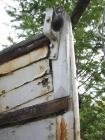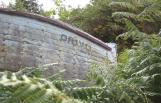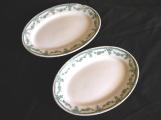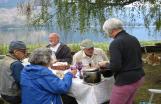14
GUNNAR BESIDE HULL OF HIS BOAT 'ECHO' Sechelt Inlet in background23 September 2003
Dorston, Sechelt Inlet, British Columbia, Canada

15
'ECHO' was a 21 1/2 ft. fishing boat with a 5 horse Vivian motor. ECHO was built and launched in 1936 by Gunnar and his father and brother.It was not a clinker boat, Gunnar informed me. "You corked the seams." "The ribs, we cut yew wood. That's pretty hard wood. We had the keel and bowstem with a natural yew wood curve."
"We started fishing out into the Gulf (Gulf of Georgia). Now we started making money and thought we needed a bigger boat." The family then built the 'ORIVO' in 1946.
16
CLOSE UP OF BOW OF GUNNAR'S BOAT 'ECHO' Details of the Yew Wood Bow Stem Cap23 September 2003
Dorston, Sechelt Inlet, British Columbia, Canada

17
This photo shows a close up of the bow of Gunnar's boat 'ECHO', detailing the yew wood bow stem and cap.According to Gunnar, "slabs of cedar would float in; there were slabs of cedar on shore and we sawed the lumber out of that." The bow stem and cap, however were shaped from a naturally curved trunk of the yew tree (taxus brevifolia nutt). The keel of the boat is fir wood. Fir and cedar trees are common to our coast. Yew trees, however have become rare. The ribs of the boat are also yew wood.
18
AMONGST THE FERNS Bow of Gunnar's Boat 'ORIVO' 38 ft. Fishboat Built in 194623 September 2003
Dorston, Sechelt Inlet, British Columbia, Canada

19
Gunnar's boat the 'ORIVO' amongst the ferns. The boat was a 38 ft. fishboat designed by Gunnar's father and also had a yew wood bow stem and cap. The family used all handtools when building their boats."The ribs, we cut by hand. Yew wood was pretty tough wood. You could never bend it cold, you had to stem it. It would take a harder bend than oak, and it would outlast oak."
"First you steam and curve the bow stem. Planking would fit around it and sawed off flush with bow. Then a false stem (bow cap) was put on the outside of that and bolted. It was airtight!" "We had a forge (for blacksmithing) and we never had coal, we used fir bark." See story 'Tools' for more information on using fir bark.
20
90 YEAR OLD GUNNAR FISHES NO MORE23 September 2003
Dorston, Sechelt Inlet, British Columbia, Canada

21
The rails in the foreground of the photo were used by Gunnar and his family to pull boats up off the beach for repair and maintenance. The rails were installed after Gunnar's fishboats were built, but they became a means by which the family, when not fishing, could generate some income by repairing other boats.Gunnar is quick to point out that money was not always exchanged and there were times when the community helped each other. His next story is about one of those times..
"I remember this one time, a local person from Egmont, he came in through the chuck (rapids nearby called Skoocumchuk) and he says, I'm in trouble, a plank fell out of my boat. So I opened up the hatch and you could look right down to the deep sea. But, as luck would have it, the plank spanned midship. We had built this ways to pull our own boats up, so we pulled him out of the water. We had spare planks by now, so we put a plank in, nailed it, corked it, and launched it for nothing."
22
GUNNAR'S FISHING LICENSE NO. PAINTED INSIDE DECK OF HIS BOAT 'ORIVO'23 September 2003
Dorston, Sechelt Inlet, British Columbia, Canada

23
This close up of the inside deck of Gunnar's boat 'ORIVO' shows the fishing license number.Fir wood boards were used for most interior work. And Gunnar mentions how solid yew wood is compared to both fir and cedar.
In the foreground of the photo is a fir wood board. Just below this board is where museum curator, Bee Jackson found two old plates that Gunnar used in the galley of the boat while out fishing. Gunnar graciously offered them to the Museum, as he hadn't even remembered they were there.
24
GALLEY PLATES FROM GUNNAR'S FISHBOAT 'ORIVO' Gunnar donated them to the Sunshine Coast Museum.23 September 2003
Dorston, Sechelt Inlet, British Columbia, Canada

25
These china plates from Gunnar's boat 'ORIVO' are hotel ware, circa 1901 - 1904. They probably came from the Union Steamships.The plates were a perfect parting gift from Gunnar, who proved to be a gracious and entertaining host.
26
DORSTON NEIGHBOURS ENJOY LUNCH UNDER GUNNAR'S BIRCH TREE23 September 2003
Dorston, Sechelt Inlet, British Columbia, Canada

27
Under the birch tree that Gunnar planted when he was 16 years old, and with Sechelt Inlet in the background, neighbours gather for Gunnar's interview and share a picnic lunch of clam chowder, biscuits, pumpkin soup and blackberry wine. Everything homemade and delicious!Dan Wilson pointed out that "Gunnar has a root cellar out back there, full of pumpkins, squash, and all sorts of wonderful things, but he doesn't eat them. Everyone here in the Inlet is a beneficiary."